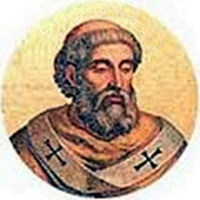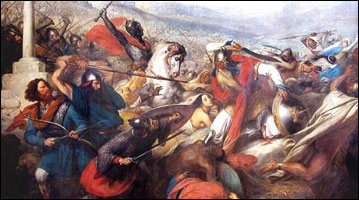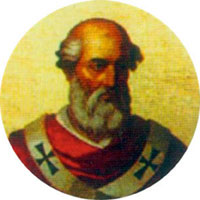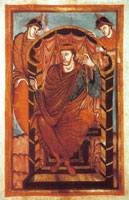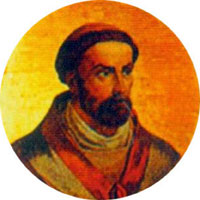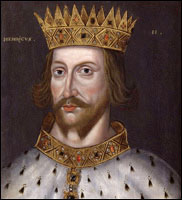THE NAME GREGORY IS DERIVED FROM THE LATIN GREGORIUS, A COGNATE OF THE GREEK GREGORIOS (VIGILANT, A WATCHMAN)! |
North Africa was a great stronghold of true Christianity when Gregory was crowned in 590. Previous to that time, the "Plague of Justinian" had wiped out from 25 to 50 million Christians in North Africa and Eastern Europe. It was devastating blow to the true Faith from which it never recovered.
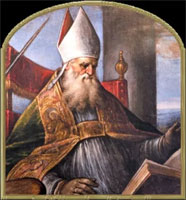 Pope Gregory I (540–604). Pope from 590 to 604. |
|
 Muhammed (570–632). |
To the delight of Pope Gregory, a greatly depopulated North Africa and Eastern Europe made the subsequent Arab conquests possible.
Pope Gregory's monks in Arabia worked closely with Muhammed, and they provided financing for his massive armies. The main target of the Muslims was the vast Christian Congregation in North Africa . . . and Eastern Europe. Additionally Gregory is called the "Apostle to the English" because Papal Roma replaced pagan Roma with the mission of Augustine of Canterbury in 597.
 Pope Gregory II (669–731). Pope from 715 to 731. |
|
 Boniface (675–754) tried to undo the work of the Irish missionaries. |
While in Roma, Boniface was given the round tonsure, and he also adopted the Latin Church date for Passover-Resurrection. Then Pope Gregory sent him to sow tares in the field planted with the good seed of the Gospel by the spiritual sons of Saint Patrick. Boniface is now called the "Apostle of the Germans."
|
|
|
The Battle of Tours was a milestone event in the history of the world. An Arab victory would have made all of Western Europe . . . including Hibernia, Muslim.
The Muslim hosts were led by Abdul Rahman al-Ghafiqi, governor-general of al-Andalus. They were supremely confident of victory when they knew that they had the support and "prayers" of Pope Gregory III.
|
|
|
Charlemagne was a fake "Roman" Emperor, as were all of his dynasty, because they were not allowed to reign at Roma. One of his grandsons named Lothar fought against his own brothers for control of the so-called "Roman Empire." Pope Gregory encouraged that deadly civil war because it was a great opportunity for the Muslims to try again to conquer the Frankish empire.
As the year 1000 AD approached, Catholics were told that the world was about to end, and the best way to prepare for the Judgment Day was to be poor....Millions did sign over their property to the Church, and it was duly notarized by the Papal canon lawyers.
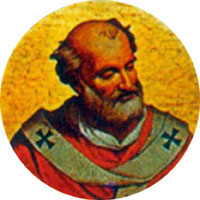 Pope Gregory V (972–999). Pope from 996 to 999. |
|
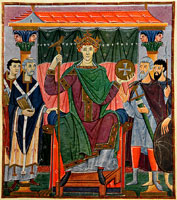 Fake "Roman" Emperor Otto III. (980–1002). Ruled from 996 to 1002. |
When Christ did not return at the dawn of the new millennium, Catholics realized that they had made a colossal mistake . . . and many tried to retrieve their property . . . but it was too late!
The 10th century was indeed the darkest of the Dark Ages, but incredibly, things actually got worse as the new century unfolded.
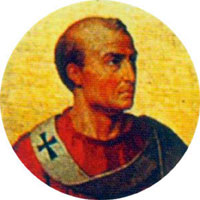 Pope Gregory VI. Pope from 1045 to 1046. |
|
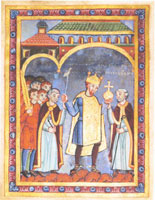 Fake "Roman" Emperor Henry III. (1017–1056). Reigned from 1046 to 1056. |
Gregory VI was succeeded by Pope Clement II, who crowned Henry III as fake Holy "Roman" Emperor.
The next Gregory, the infamous Hildebrand, was a veritable Hildabeast.
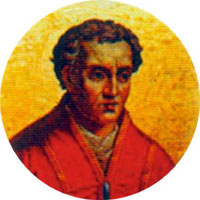 Pope Gregory VII Pope from 1073 to 1085. |
|
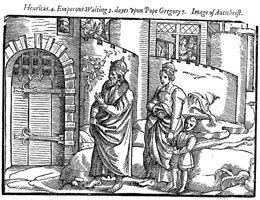 Emperor Henry IV with his wife and Emperor Henry IV with his wife and child waiting for 3 days at Canossa. |
Fake "Roman Emperor" Henry IV had to wait for 3 days outside Canossa Castle, in humble penitence, before Pope Gregory would receive him. By debasing himself, Henry was able to keep his throne, but the humiliating and shameful incident reverberated down through the centuries.
|
|
|
After the assassination of the archbishop, Henry hastened to forestall the dreaded excommunication by annexing Ireland:
In the summer of 1171 the Pope sent two cardinal legates into Normandy to hear Henry's case and discuss with him the terms under which he might receive absolution for the murder of Becket, but the King, fearing excommunication, did not wait to meet with him. On 6 August he returned to England, having decided that this would be a good time to embark upon the conquest of Ireland, which had been granted to him by Pope Adrian IV in 1155. On 16 October he set sail with an imposing army from Milford, Haven, landing the next day at Waterford and riding north to Dublin where he established his winter quarters. (Weir, Eleanor of Aquitaine, p. 186).
One of the 2 cardinal legates who was sent by Pope Alexander III was the short-lived Pope Gregory VIII.
Reference
Weir, Alison. Eleannor of Aquitaine. Ballantine Books, New York, 1999.
